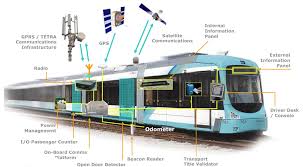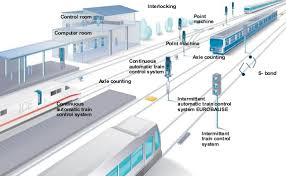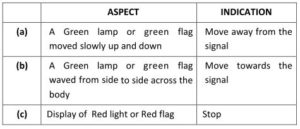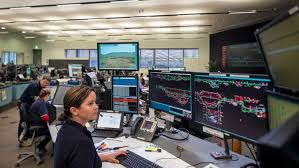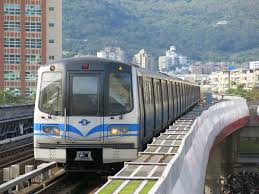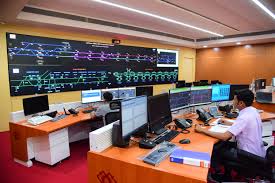Metro Rail Signalling And Control System
Metro Rail Signalling And Control System :- (1) The following signals shall be used for controlling the movements of trains on the Metro Railway namely:-
(a) cab signals.
(b) fixed signals. and
(c) hand signals.
(2) The aspects displayed by fixed signals are the same by day and by the night, in open and in tunnels.
(3) A fixed signal be placed, where practicable, on the left hand side of the track to which it refers, unless authorized otherwise under special instructions, and shall be visible from such a distance as will enable a Train Operator to brake a train from twenty five kilometer per hour speed to stop before reaching the fixed signal and a repeater signal shall be provided at locations where due to obstructions such visibility is not available, except in depot. Provided further that, where high speed Cut Out mode is provided this speed shall be forty kilometer per hour. This signal sighting distance shall be specified under special instructions.
Description of signals
(1) Cab Signals
(i) Train movements on running tracks shall normally be governed by the Automatic Train Protection system which displays to the Train Operator in the operating console-
(a) actual speed of the train.
(b) the maximum permitted speed at each point of travel.
(c) the distance the train is currently authorized to travel (where provided).
(d) system alarms; and
(e) Messages.
(ii) if the target speed indication and the target distance indication, where provided, are greater than zero, the indication is referred to as “PROCEED” indication.
(iii) if either of these indications is “0”, the indication is referred to as “STOP” indication;.
(iv) The Train Operator is authorised to drive his Train up to the indicated speed as far as authority has been given for such purpose.
(2) Fixed Signals
(i) on main lines, fixed signals are color light signals, either showing two 15 aspects or three aspects.
(ii) Two aspects fixed signals, where provided, shall be capable of showing a “Red” or a “White or violet” aspect.
(a) a “Red” aspect indicates that a train must be brought to STOP short of the signal.
(b) a “White or violet” aspect indicates that the route is set and locked but may not be fully clear up to the next fixed signal and a train operating under cab signals may proceed under the authority of the cab signals but a train operating on the sole authority of line side signals must stop and seek instructions from the Traffic Controller.
(iii) Three aspect signals, where provided, shall be capable of showing a “Red”, “White or Violet” or “Green” aspect.
(a) a “Red” aspect indicates that a train must be brought to STOP short of the signal.
(b) a “White or Violet ” aspect indicates that the route is set and locked but may not be fully clear up to the next fixed signal and a train operating under cab signals may proceed under the authority of the cab signals but a train operating on the sole authority of line side signals must stop and seek instructions from the Traffic Controller.
(c) a “Green” aspect indicates that the route is cleared to the next fixed signal and the train may proceed as far as the next fixed signal.
(iv) When a fixed signal is not in use, the aspect shall be covered and the cover shall display two crossed white bars on a black background, the bars being not less than thirty centimeter long and ten centimeter wide.
(3) Depot Signals
(i) in depots, fixed signals may be colour light or position light type. Colour light type using Red and Yellow aspects should be used in the manner as specified below:
(a) a “Red” aspect indicates that a train must be brought to STOP short of the signal;
(b) a “Yellow” aspect indicates that the route is set, locked and clear and a train may proceed in “Restricted Manual” mode as far as the line is clear and the Train Operator must keep a good look out for any obstruction.
(ii) in position light type signaling
(a) two white lights displayed horizontally shall mean that a train must stop.
(b) two white lights displayed at an angle shall mean that a train may proceed in Restricted Manual mode as far as the line is clear and the Train Operator must keep a good lookout for an obstruction.
(iii) the Depots and stabling lines shall be isolated from the running line through an approved means.
(4) Hand Signals
(i) hand Signals shall normally be used only for the shunting of work train in depot, or at the site of work, or in extreme emergency.
(ii) any light other than “Green” or any object waived violently shall be interpreted as a stop signal.
(iii) “STOP” shall be indicated by.
(a) a Red lamp.
(b) raising of both arms above the head.
(c) waving a white light rapidly from side to side
(d) a Red flag;
(iv) “PROCEED” shall be indicated by a Green lamp or green flag held steadily.
(v) hand signals for shunting and train movements shall have the following configurations:-
(vi) when during cautious driving or shunting, the speed of a train is to be reduced, the hand signal for movement shall be given at a slower and slower rate and when a stop is required, a STOP signal shall be given;
(vii) each Station Control Room shall have at least one hand lamp capable of displaying Red, Green and White aspects, one Red and one Green flag readily accessible and in working order and each Station Controller shall be conversant with t h e i r location and their proper use;
(viii) each Metro Railway employee involved in the shunting of work trains, the operation of work trains at a maintenance site and the operation of work trains within an Engineer’s Possession, shall carry a hand lamp capable of displaying Red, Green and White aspects in working order and shall be conversant with its proper use and in addition, he shall also carry a Red flag and a Green flag.
